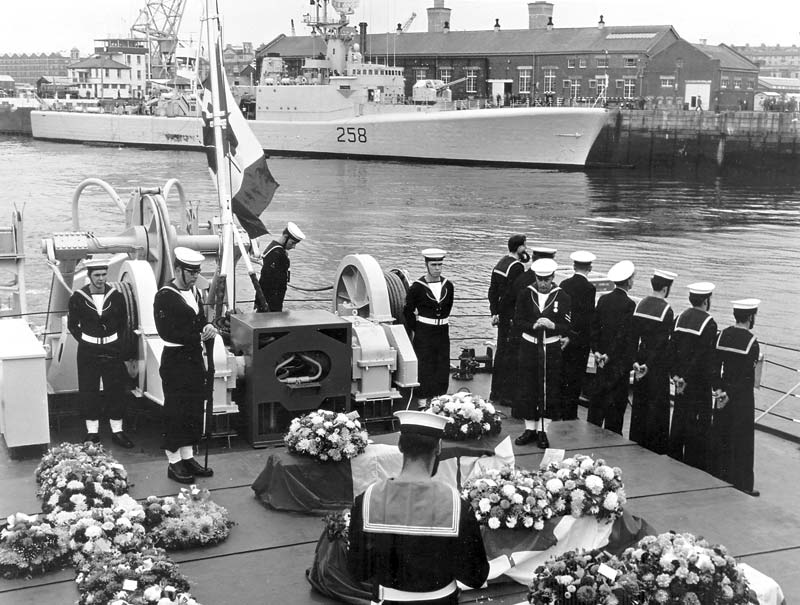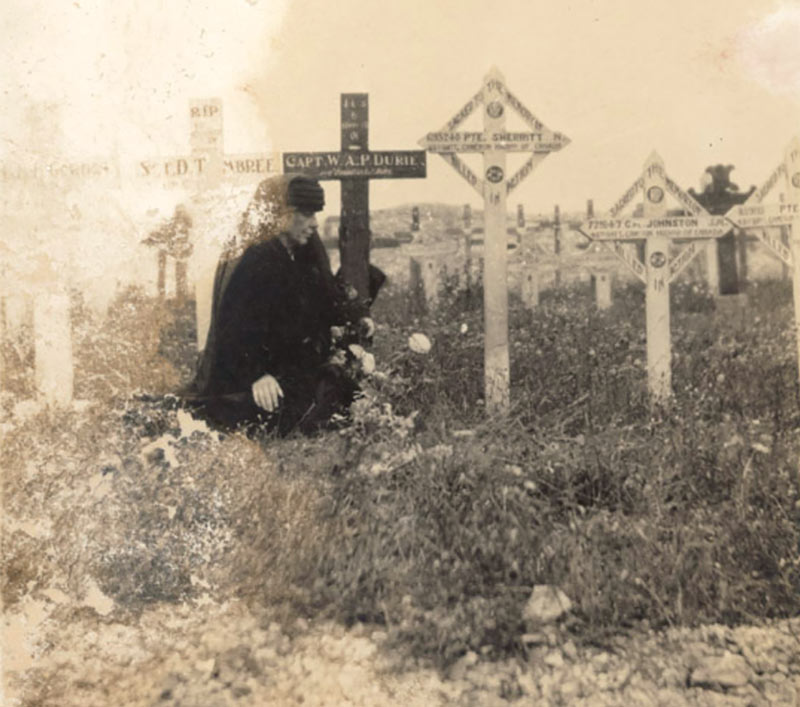Fewer than 100 Canadians who died while serving in the world wars were repatriated for burial

A firing party (top) leads the procession during Lieutenant Herbert Corey’s funeral in his native Jacksonville, N.B., on March 12, 1940. Corey (right) died from wounds sustained on a shooting range in England in March 1941, the war’s first Canadian army officer killed overseas. The flag is removed from his coffin (left) before burial. [Christopher Clark]
Until the horrific explosion and fire in HMCS Kootenay which caused nine sailors’ deaths in 1969, Canada’s policy was that all service personnel who died abroad were to be buried overseas. Despite this policy, though, the remains of several Canadian fatalities of the world wars were returned to Canada for burial.
Most Canadian personnel who went overseas during the wars served in Britain at one time or another. Although British officials disapproved of the return of remains from Britain and tried to stop it, Canadian authorities were less inclined to discourage attempts and occasionally bent the rules. Repatriation from elsewhere was strictly forbidden.
The Commonwealth War Graves Commission (CWGC) is responsible for all cemeteries of both world wars. It has not created any official lists of Canadians whose remains were sent home, but it does have some names.

A funeral service is held on the deck of HMCS Saguenay in Plymouth, England, after a 1969 explosion and fire aboard HMCS Kootenay (in background) killed nine crew and injured 53. [Memorials in Ottawa]
This information was “provided by researchers, as most occurred without [the Commission’s] knowledge,” said Roy Hemington, records data manager at CWGC headquarters in Maidenhead, west of London. He provided the details of 72 First World War and two Second World War cases.
Similarly, the Canadian agency of the CWGC in Ottawa does not prepare official lists of those repatriated. But it is aware of some, as the agency’s Catherine Paterson notes, “generated from our internal database…during the course of our regular work.” She supplied details of 52 individuals from the First World War and one from the Second World War.
Combining both lists and eliminating overlaps—plus adding three found through personal research—results in 93 Canadian military deaths during the First World War whose remains were repatriated for burial in Canada. Here are some of their stories.

Lieutenant William Frederick Nelson Sharpe of Prescott, Ont., crashed and died while training with the Royal Flying Corps in 1915. [DND]
The first remains to be repatriated were those of Lieutenant-Colonel Frank Strange, a 50-year-old Canadian Ordnance Corps officer serving at 1st Canadian Division headquarters in Britain. He died of meningitis on Jan. 6, 1915, and was buried in the Cataraqui Cemetery in Kingston, Ont.
Pre-war pilot William Sharpe, 22, was gazetted as a lieutenant in the Royal Flying Corps on Feb. 3, 1915. He became Canada’s first aerial casualty of the war when he perished in an aircraft accident at Shoreham, West Sussex, the next day. He was buried in the Sandy Hill Cemetery in Prescott, Ont.
Comrades disinterred his remains and returned them to Britain.
Private Jairus Maus, 31, of the 16th Battalion (Canadian Scottish) was wounded during the Second Battle of Ypres and evacuated to Britain. His mother and sister were visiting him in 4 General Hospital in Lincoln when he died on Dec. 5, 1915. They returned to Canada with his remains for burial in Paris, Ont.
Gunner John Cleary, 21, of 2nd Brigade, Canadian Garrison Artillery, was gassed during a bombardment at the front on May 26, 1917. Four nights after he was evacuated to a hospital, he was severely burned during an air raid. He was transferred to the City of London Military Hospital. Cleary had a particularly painful death on June 9, 1918, from pneumonia caused by the poisoning. He was buried in Corkery, Ont.
Captain Oliver Mowat, 25, served with 68th Battery, 6th Brigade, Canadian Field Artillery, in Northern Russia. He perished from his wounds at the U.S. Army’s 337th Field Hospital on Jan. 27, 1919. He was buried in a local churchyard, but his comrades disinterred his remains and returned them to Britain with the brigade’s baggage. His father collected them there for burial in Campbellton, N.B.
Grace Bolton, 28, a Voluntary Aid Detachment nurse serving in 2nd Northern General Hospital in Leeds, was the only female whose remains were repatriated. She contracted pneumonia on duty and died on Feb. 16, 1919. She was buried in Montreal’s Mount Royal Cemetery.

RFC Major Charles Sutcliffe of Brampton, Ont., died after he was shot down in a dogfight with three German planes in June 1917, just two months after he deployed to the front. [Canadian Virtual War Memorial]
After pilot training, Major Charles Sutcliffe, 25, of Lindsay, Ont., went to France for front-line service with 54 Squadron, Royal Flying Corps, in April 1917. On June 6, his formation of 24 Sopwith Pup fighters was attacked by 40 enemy planes deep behind German lines.
In the ensuing fight, Sutcliffe was driven farther into enemy territory. He fought off three German planes until he was shot down at Épinoy, France. He crash-landed, set his plane on fire and then died of his wounds. The Germans gave Sutcliffe a military funeral and he was buried in a privately owned vault in a civilian cemetery in Épinoy.
In 1925, Sutcliffe’s father convinced French authorities he was repatriating an American soldier to New York. As the Americans allowed repatriation, the French did not object. Sutcliffe’s body was shipped to New York and then to Lindsay for reburial in his family’s vault.
Captain William Arthur Durie, 36, was killed by mortar fire while commanding ‘A’ Company, 58th Battalion (Central Ontario), near Lens, France, on Dec. 29, 1917. Durie’s mother, Anna, had petitioned officials continuously since 1920 to let her bring her only son’s body back to Canada from Corkscrew British Cemetery near Lens—but without success.
After two failed attempts, her chance came in 1925 when officials began to disinter bodies from the smaller cemetery for reburial in the larger Loos British Cemetery.
Anna hired local help to dig up her son’s freshly reburied body on the night of July 25. They removed most of his remains from the coffin and placed them in a valise.
Anna brought Durie’s remains to Canada as baggage and reburied him in Toronto’s St. James’ Cemetery. Canadian newspapers reported the event as an honourable act.

His mother petitioned officials continuously to let her repatriate her son’s body, to no avail. She hired locals to dig up his remains in 1925 and smuggled them back to Canada in a suitcase. [City of Toronto Archives]
There were significantly fewer repatriations of service fatalities from overseas during the Second World War. And one of them involved a degree of trickery.
Flying Officer Reginald Hepburn, 29, of Brighton, Ont., and his British navigator were making a training flight in a twin-engine Bristol Beaufighter over Yorkshire on Jan. 8, 1943. They were serving in 2 (Coastal) Operational Training Unit, based at RAF Catfoss near Hull. Operational training was the final step before service in a Coastal Command squadron.
He had already…cremated the remains and returned to Canada with them.
Suddenly, they encountered a severe snowstorm and Hepburn lost control of the aircraft. It crashed just east of the village of Bewholme, killing both occupants. Hepburn was buried in the local churchyard at Brandesburton. But the story does not end there.

Flight Lieutenant Donald Hepburn died in 1942, nine months before brother Reginald, when his bomber was shot down in a raid over Germany. Reginald’s ashes were brought back to Canada; Donald’s were buried in Germany. [Canadian Virtual War Memorial]
Hepburn’s uncle was Lieutenant-Colonel Channell Hepburn, a Canadian military chaplain. He was a veteran of the First World War and had been awarded the Military Cross for his actions at the Somme. Hepburn requested that his nephew’s body be exhumed and returned to his mother in Canada.
At the same time, Hepburn shrewdly followed a second course of action. By the time military authorities told Hepburn his nephew could not be repatriated, he had already obtained a Home Office licence, cremated the remains and returned to Canada with them.
The ashes were buried in the family plot at Crystal Lake Cemetery in Stanstead, Que., in November 1943.
His younger brother, Flight Lieutenant Donald Hepburn, 23, of 97 Squadron, RAF, had died nine months earlier. His Lancaster bomber was shot down over Augsburg, Germany, during a daylight mission.
Had the thought of a second son buried overseas been too much for the family to bear—and the reason Hepburn went to unusual lengths to return his nephew’s ashes?

Flight Sergeant Horace Downing was in a torpedo bomber that collided with another plane during an exercise off Scotland in 1943. [Canadian Virtual War Memorial]
At least one other Canadian airman had his remains returned home.
Flight Sergeant Horace Downing, 25, of Harrison Hot Springs, B.C., was a wireless operator and air gunner serving with Australia’s 455 Squadron in Coastal Command. On May 24, 1943, he was aboard a Handley Page Hampden torpedo bomber participating in an air-launched torpedo exercise.
About eight kilometres off Scotland’s Aberdeenshire coast, the Hampden collided with a Bristol Beaufighter of 235 Squadron, RAF. The crash killed the crews of both aircraft: four on the Hampden and two on the Beaufighter.
Only the bodies of Downing and the bomb aimer were recovered from the Hampden, while neither body was recovered from the Beaufighter. Downing’s body was cremated, and his ashes were sent to Canada. They were buried in the Pleasant Valley Cemetery in Vernon, B.C.
Hepburn and Downing both appear on the CWGC list, but only Hepburn is on the Canadian agency’s list. Interestingly, neither organization has the details of a third Canadian whose remains were repatriated to Canada during the Second World War—the only body to come home.
Lieutenant Herbert Corey of Jacksonville, N.B., was a prewar militiaman. He joined New Brunswick’s Carleton Light Infantry in 1932 and was commissioned as a lieutenant in 1934.
When the Carleton Light Infantry and the York Regiment amalgamated in 1936 as the Carleton and York Regiment, Corey remained with the new unit. He immediately volunteered for active service when the war broke out in September 1939.
Due to a heart murmur, he did not have to serve overseas but “felt very strongly about going…and could not ask his men to go where he could not,” said his wife Louise, recounted by his grandson, Christopher Clark of Woodstock, N.B.
Clark also said that his “grandmother was a very meticulous record keeper. She saved everything…to show my mother who her father was and what he had done.” Corey’s daughter Sharon was 10 months old when he was killed.
The Carleton and Yorks were assigned to 3rd Brigade, 1st Canadian Division, and were among the first Canadians to arrive in Britain. Corey deployed two weeks before most of the division to train as a mortar, Bren gun and anti-tank rifle instructor. Shortly after arrival in Britain, one of his first acts was to send a two-word telegram to his wife: “ARRIVED SAFELY.”
Corey commanded the new Bren gun carrier platoon. “His platoon had [the carriers] polished and cleaned so much that the paint was almost off, in the week since we got them,” recalled fellow officer Captain Rex Clarke.
The battalion was engaged in weapons practice on a rifle range at Camp Aldershot on March 8, 1941. While a jammed rifle was being cleared it accidentally went off and the ricocheting bullet hit Corey in the abdomen. He died in the Cambridge Military Hospital the next day.
The coroner’s inquest and death certificate stated Corey, 27, was killed by an “accidental gunshot wound.” He was the first Canadian army officer of the war to lose his life overseas.
Corey was a popular officer and, with the permission of the battalion’s commanding officer, Lieutenant-Colonel Hardy Ganong, arrangements were made to ship his body home for burial. But first, there was a full military funeral in Aldershot’s garrison church on March 12. Corey’s casket was borne on one of the new Bren gun carriers. His entire battalion attended, along with soldiers representing almost every unit in the division.
After the funeral, his body was shipped to Canada for burial. On March 29, another military funeral was held and Corey was laid to rest in the Jacksonville cemetery. The local Legion branch places a wreath on his grave every Remembrance Day.
—
One authorized repatriation

Canada’s Tomb of the Unknown Soldier at the National War Memorial in Ottawa contains the remains of an unidentified Canadian soldier killed in France during the First World War. [iStock]
In 1996, The Royal Canadian Legion proposed establishing a Tomb of the Unknown Soldier at the National War Memorial in Ottawa as a millennium project for 2000. Other veterans’ organizations and various federal government departments supported the idea.
It was decided that the Unknown Soldier should be removed from a cemetery associated with the Battle of Vimy Ridge. The Commonwealth War Graves Commission (CWGC) agreed to locate remains of an unknown Canadian soldier from an appropriate cemetery. It selected Cabaret-Rouge British Cemetery, two kilometres west of the Canadian National Vimy Memorial.
The CWGC supported the repatriation of the remains, provided Canada would not attempt or assist anyone in trying to identify them and would continue to support the policy of non-repatriation of war dead. Canada agreed.
At a solemn ceremony on May 28, 2000, the remains were laid to rest in a specially designed sarcophagus in front of the National War Memorial.
—
By the numbers
Locations of Canada’s war dead
South African War (Boer War): 267 dead. All are buried or commemorated in South Africa.
First World War: Burials are in France (28,424), Belgium (7,049), Canada* (6,846), Britain (3,898) and 27 other countries. Those who have no known grave are commemorated on the Canadian National Vimy Memorial (11,285), the Menin Gate Memorial to the Missing in Ypres, Belgium, (6,994) and the Beaumont-Hamel Newfoundland Memorial (820), representing almost 30 per cent of all dead.
Second World War: Burials are in Canada*
(9,722), Britain (8,817), France (7,851), Italy (5,916), Netherlands (5,712), Germany (3,103), Belgium (1,750) and 63 other countries. The largest number of the 8,506 with no known grave are 3,050 air force personnel commemorated on Runnymede Memorial in Britain.
Korean War: 516 dead, buried or commemorated in Korea (399), Canada* (90) and Japan (27).
Afghanistan: 158 buried or cremated in Canada.
Locations of Canada’s peacetime missions dead
Post-Second World War (mainly NATO): 1,490 service personnel and dependents are buried abroad. Their graves are in Germany (955), France (441), Britain (84) and four other countries. The largest number
is 474 buried in Werl, Germany.
Peacekeeping: 117 fatalities from 18 United Nations and other international missions. They are buried in Canada (70), Palestine (22), Egypt (10), Cyprus (9) and three other countries.
*Died in Canada after returning from overseas or before deployment overseas.
Advertisement























